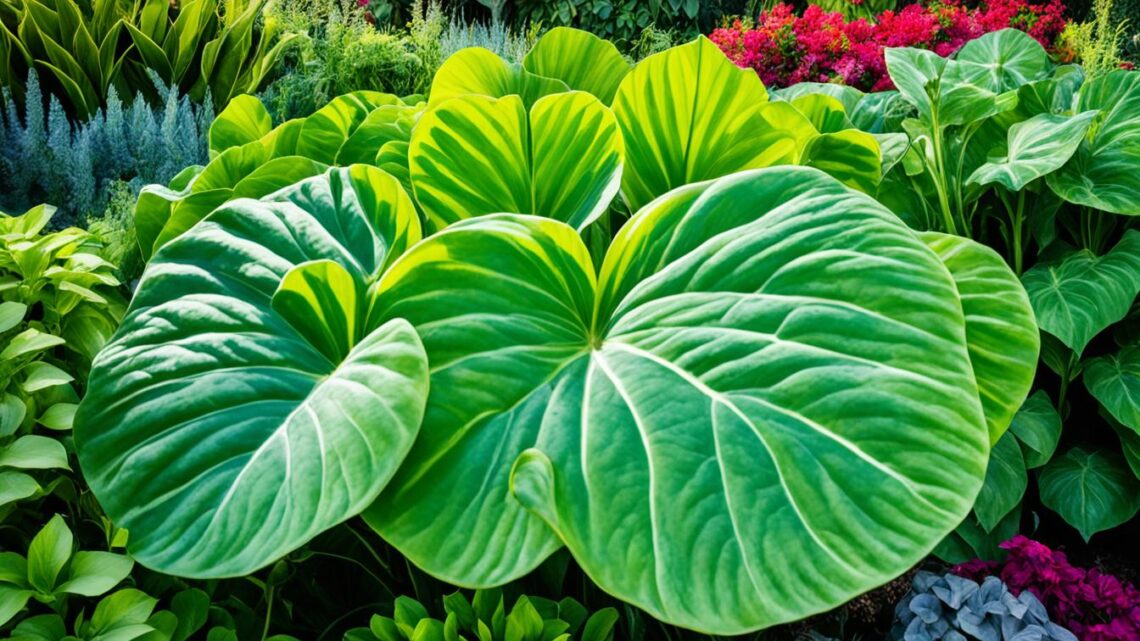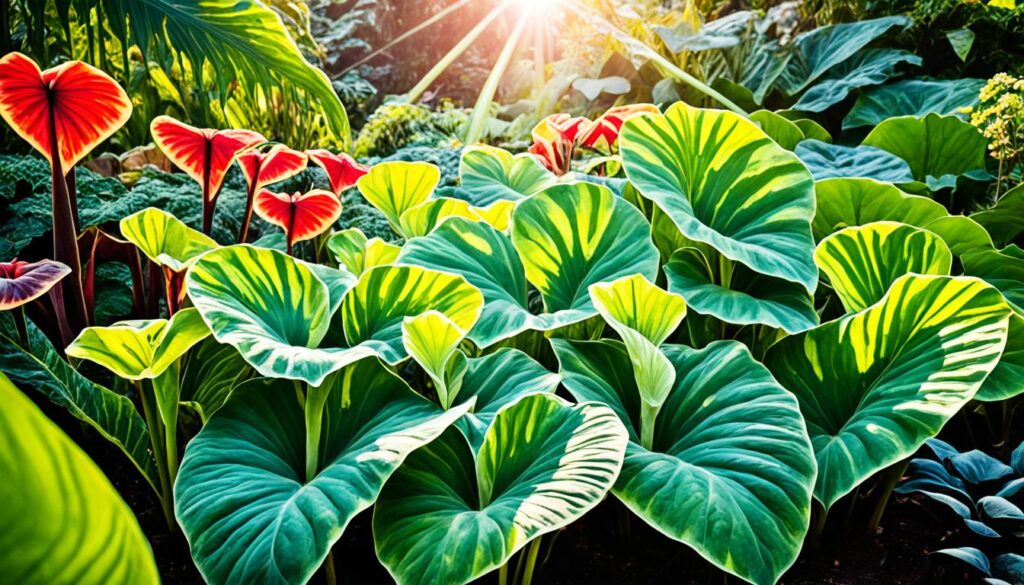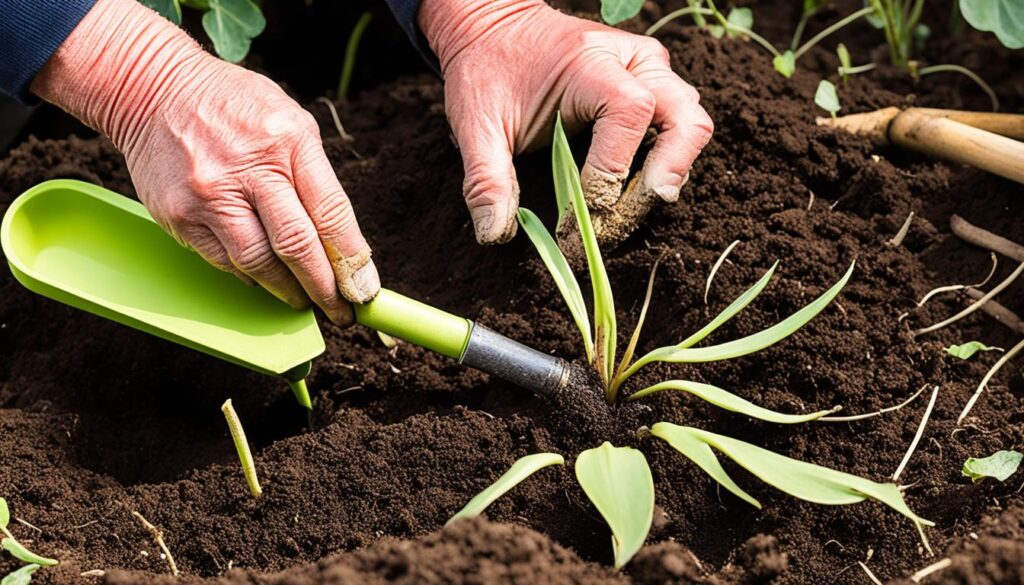
Love making your home or garden into a tropical paradise? Consider Elephant Ear plants. They instantly make any area green and beautiful. These large plants are eye-catching, making your space look like a lush oasis. But are they easy to take care of?
Elephant Ear plants, also called Taro or Eddoe, are available in many types. Each type has different leaf shapes, colors, and sizes. You can choose from giant plants that reach 8 feet high to smaller ones at just 3 feet. With the right selection and care, your garden will be the talk of the town.
Introduction to Elephant Ear Plants
Elephant ear plants are part of the Araceae family and are sometimes known as taro or dasheen. They are tropical perennials famous for their large, eye-catching leaves. These leaves can be green, purple, or variegated. With many names and types, they are a favorite for many gardeners.
Common Names and Botanical Classifications
They are called elephant ears, elephant’s ear, taro, and dasheen. They are in the Alocasia, Colocasia, and Xanthosoma families. Each type has its own look and special features.
Plant Types and Mature Sizes
These plants vary a lot in size. Some are small while others grow very big. Over 200 kinds of taro have been found. Most are between 8 inches and 9 feet, but many are 3 to 5 feet tall or wide.
There is a type for every garden, whether you have lots of space or just a little.
Growing Conditions for Elephant Ear Plants
Sun Exposure and Soil Requirements
Elephant ear plants love being under partial shade or full sun. The ones with darker leaves enjoy more shade to avoid losing their bright color. They grow best in rich, moist soil that drains well. Adding organic matter to the soil is important. These plants like water but not too much, as they don’t do well in soggy soil.
Watering and Fertilizing Needs
To grow well, elephant ears need frequent feeding. Use a fertilizer that is high in nitrogen during their growing season. Keep the soil moist, as they really enjoy water. But remember, too much water harms them.
With the ideal conditions, their massive leaves can reach from 3 to 10 feet in both height and width. This makes them quite the sight in any garden.
| Characteristic | Requirement |
|---|---|
| Sun Exposure | Partial shade to full sun |
| Soil Type | Rich, moist, well-drained with organic matter |
| Watering | Consistent moisture, avoid soggy soil |
| Fertilizing | Regular high-nitrogen fertilizer during growing season |
| Mature Size | 3 to 10 feet tall and wide |
If you want beautiful elephant ear plants in your garden, focus on the right growing conditions. Pay attention to sun exposure, soil quality, consistent watering, and using a proper high-nitrogen fertilizer. This will bring you the best results. These plants are perfect for adding a tropical touch.
Elephant Ear Plants for Different Climates
Elephant ear plants, known as Colocasia and Alocasia, love warm, humid places. Yet, they can live in different places based on the type.
In USDA Hardiness Zones 10-11, they do very well. These areas are much like where they come from in Southeast Asia. They get the warmth and humidity they need there.
If you live in a cooler area, you can still grow some types. In colder places, you might treat them as yearly plants. Or, bring them inside when it gets cold. Colocasia can handle up to Zone 8. Alocasia does best in Zone 9 or 10. In these areas, you can dig up the roots and keep them inside over winter.
- Colocasia ‘Coffee Cups’ can grow in Zones 8 to 11, which is wider than some other types.
- Alocasia ‘Calidora’ does well from Zones 9 to 11, making it good for slightly cooler places.
- Alocasia Macrorrhiza ‘Blackstem’ thrives in Zones 9 to 11, showing it can grow in various warm places.
- Alocasia ‘Purple Prince’ is best for Zones 9 to 11, like many other Alocasia types.
Whatever the climate or hardiness zone, these plants need lots of water and warm soil. Ideally, the soil should be around 80°F. With care and the right conditions, they can fit into many gardens, both tropical and temperate.
Popular Elephant Ear Plant Varieties
There’s a wide selection of elephant ear plants, each with special traits to enhance your garden. You might like ones with unique colors, big sizes, or interesting shapes. There’s a type for everyone.
Colocasia Cultivars
‘Black Magic’ catches the eye with its deep purple-black leaves. ‘Mojito’ has huge green leaves, and ‘Thailand Giant’ can grow up to 8 feet. Also, look for ‘Black Coral’ and ‘Royal Hawaiian Aloha’ for other great choices.
Alocasia Hybrids and Species
The ‘Amazonica’ hybrid features amazing leaves. ‘Frydek’ and ‘Yucatan Princess’ have beautiful patterns. A. rugosa stands out with its tall, stiff leaves.
Xanthosoma Selections
Xanthosoma elephant ears have their own special appeal. The ‘Lime Zinger’ variety, with its bright arrow-shaped leaves, is quite unique.

Choose from bold Colocasia, sculptural Alocasia, or vibrant Xanthosoma. Each type will add something special to your garden. Try a mix of these amazing plants for a truly unique garden experience.
Caring for Elephant Ear Plants
Pruning and Maintenance
Keeping your elephant ear plants in top shape isn’t hard. With a little regular care, these lush greens can really shine. Proper pruning and maintenance are key. This helps these tropical wonders do well in your garden.
Start by snipping off any yellow or dying leaves. Use sharp and clean pruners for this. Cut them at their base. If the leaves are drooping or too old, they can go too.
In fall, when the plant’s leaves turn brown and die, it’s time for a bigger trim. Cut the entire plant down to the ground. This step gets the plant ready for its winter sleep. After this, you just need to keep up with watering and feeding during the growth seasons.
These plants like warm weather, between 18-29°C. Feed them a balanced liquid fertilizer every other week for new growth. And remember, repot them every few years when their roots outgrow the pot.
Just remember to care for, prune, and maintain these plants. Then, your elephant ear plants will become an amazing part of your garden. They will bloom beautifully for many years.
Propagating Elephant Ear Plants
Division and Tuber Propagation
Propagating elephant ear plants is a fun way to grow your garden or gift a friend. Dividing the plant is the best way to do this. In either spring or fall, dig up a healthy clump and separate the tubers or corms gently. Each piece should have a growth node. This ensures they will grow well.
After separating, let them dry for a week. Then, plant them 4-6 inches deep in good soil. This waiting period and planting depth can prevent diseases. Remember, it’s rare for these plants to grow from seeds directly. So dividing them is much better.

Using tubers is another way to get more plants. In the fall, dig up the tubers and let them dry for a week. Then, keep them in a cool, dry spot for winter. Come spring, plant them deep and you will see new plants grow.
No matter how you do it, keep your tools clean. Also, make sure the plants get enough water, light, and balanced food as they grow. With careful attention, you’ll soon have a bunch of beautiful elephant ear plants.
Container Gardening with Elephant Ear Plants
Elephant ears are an amazing pick for your container garden. They’re not just beautiful; they also do well in pots. This makes them perfect for adding a vibrant touch to your patio or balcony. They’re great for both experts and new gardeners.
One of the main things to remember with elephant ears is the size of the pot. You need a big container, about 12-18 inches across, with good drainage. This allows the roots enough space to grow. Use a top-notch potting mix full of nutrients for these plants.
Here’s how to plant your elephant ear. Put the tuber or rhizome 4 inches below the soil, root side down. Keep the soil damp all through the growing season. Also, feed them regularly with a water-soluble fertilizer to promote healthy growth.
What’s great about elephant ears is they go well with many other plants. Placing them next to bananas, cannas, and caladiums makes your garden look tropical. Try out different combinations to find the best look for your patio plants.
Keep in mind, elephant ears don’t like the cold. In colder areas, you’ll need to protect them in winter. You can bring them inside or store the tubers until spring to plant them again.
Trying container gardening with elephant ears is a fun way to enhance your outdoor area. Use the right pot, soil, and give them some care. Then, enjoy their big, lush leaves throughout the year.
Overwintering Elephant Ear Plants
In colder areas, keeping your elephant ear plants safe is a must. For those in the ground, cover them with a thick layer of mulch once fall starts. This will protect them from the cold. Alternatively, you can take the tubers out after the first frost, let them dry, and keep them somewhere cool and dry for winter.
For plants in pots, move them inside and find a cool, dark spot for them. Keep them there until it’s consistently over 65°F outside. Then, you can put them back into the ground or pots. Make sure to check them regularly to make sure they’re okay and not affected by bugs or rot.
Whether planted in the ground or in pots, the right care in the winter is key. Follow these steps and your elephant ear plants will thank you with a beautiful show come spring.



